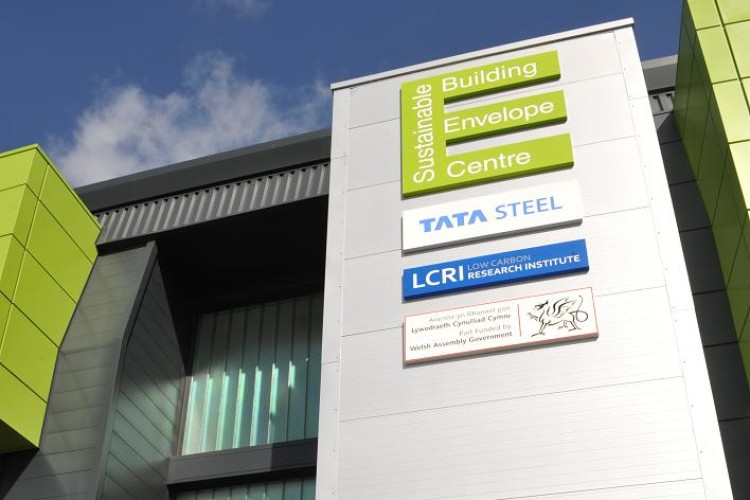The Centre is a result of a collaboration between the Welsh Assembly Government, the Low Carbon Research Institute LCRI) and Tata Steel.
The Sustainable Building Envelope Centre (SBEC), based at Tata Steel’s site at Shotton in North Wales, will be a showcase for sustainable products and used to test and monitor new integrated heating, energy and ventilation systems on the fabric of the building. At SBEC, a team of researchers and technologists will create building façades – the walls and roofs – capable of transforming buildings from being energy consumers into energy generators.
SBEC was designed by the Welsh School of Architecture (WSA) in partnership with Tata Steel and already incorporates several prototype renewable energy systems that will be tested and monitored as part of the initial work programmes.
Launching the facility, the First Minister said: “Today sees the fruit of our commitment to bring together Wales’s vital resources of expertise and capability in the academic and manufacturing industry. This Centre will showcase practical solutions for a sustainable future. It shows how we can optimise Wales’s strengths in research and development in engineering and technology, and also in the manufacture of steel products for the vital construction sector. It is good to see this development in North Wales turning sustainable ambition into reality.”
Deputy First Minister and Minister for Economy and Transport Ieuan Wyn Jones said: “This centre is leading the development of renewable energy, especially photovoltaic and solar air technologies, and introducing these techniques to the construction industry. Our programme of Economic Renewal for Wales stresses the importance of anchor companies such as Tata – and the need for us to encourage the growth of green jobs.”
Professor Phil Jones, Chair of the LCRI and Head of the Welsh School of Architecture,said the collaboration is at the leading edge of sustainable building technology development and is targeting solutions that will make a significant impact on the modern built environment.
“SBEC aims to develop practical, economic and aesthetically pleasing solutions that will work equally well in new build and retrofit situations. This last point is critical, as the stretching CO2 and energy reduction targets will not be met unless cost effective ways can be found to upgrade the existing building stock.”
Daniel Pillai, Director of SBEC,explained the strategic significance of the project with respect to Wales’s integrated energy strategy: “The opportunity for macro-scale, micro-generation is enormous and can make a significant contribution towards our global targets in renewable energy. The “sustainable” site at Shotton is already benefiting from the development of a community energy-from-waste plant and is also home to the visionary photovoltaic research and development centre.
“Our vision is to functionalise the roofs and walls of buildings and transform them from being energy consumers into energy generators. SBEC is without doubt one of the most exciting projects I have ever been involved in, and we are delighted to be working so closely with both the LCRI and the Welsh Assembly Government.”

The £6.5 million centre is one of the ground-breaking research projects to come out of the£34 million Low Carbon Research Institute (LCRI) Energy Programme, which is supported by the European Regional Development Fund through the Welsh Assembly Government.
Led by the Welsh School of Architecture at Cardiff University and backed by five other Welsh universities*, the LCRI is designed to drive forward cutting-edge research to secure a low carbon future for Wales, create green jobs and help business to develop sustainable products and technologies.
SBEC, which is being established in partnership with Tata Steel on its Shotton site in Deeside, supports Wales’s aspiration to become the exemplar for sustainable construction in Europe.
The aim is twofold:
To accelerate the delivery of low and zero carbon solutions for the Welsh built environment to meet the challenging environmental targets set by the Welsh Assembly Government.
To increase economic benefits for Welsh supply chains by supporting the commercialisation of these solutions on a global basis.
A team of eighteen people at SBEC, including staff from the LCRI and Tata Steel, will be involved in the design, modelling, prototyping, testing and monitoring of a suite of heating, ventilation and energy solutions based primarily on photovoltaic and solar thermal technologies.
They will focus on the practical integration of these systems into the full range of building types, and will be collaborating with a wide range of development partners.
* The 5 universities are: Glyndwr, Bangor, Swansea, Aberystwyth and Glamorgan
Got a story? Email news@theconstructionindex.co.uk



